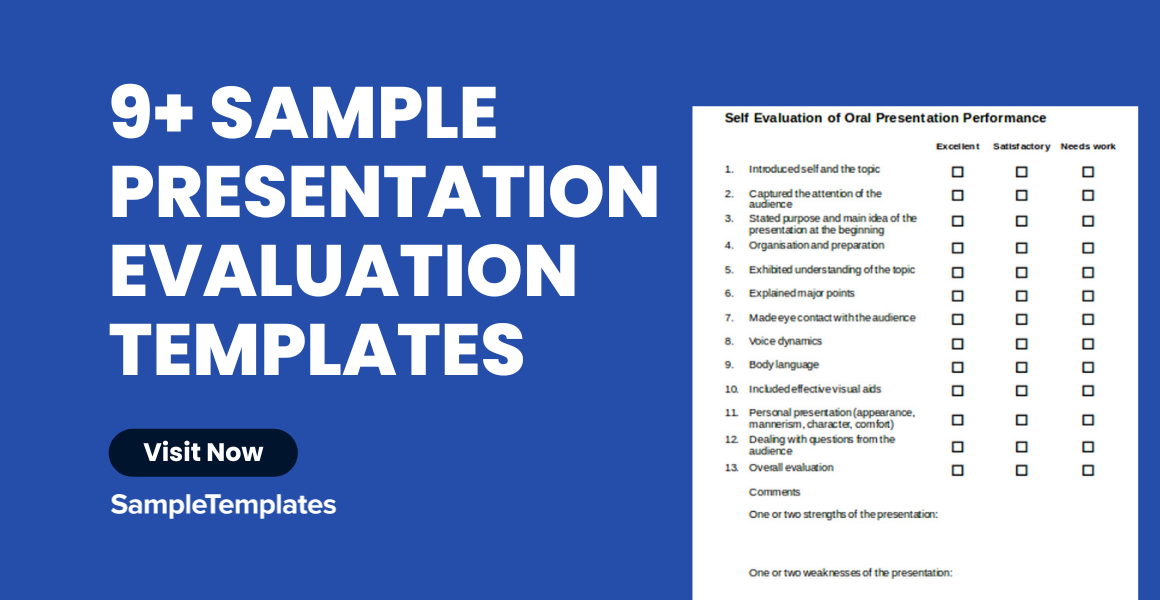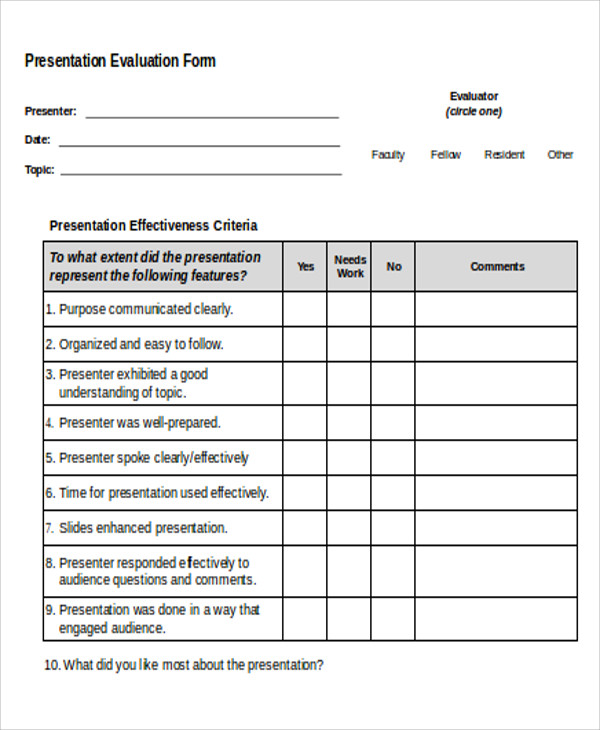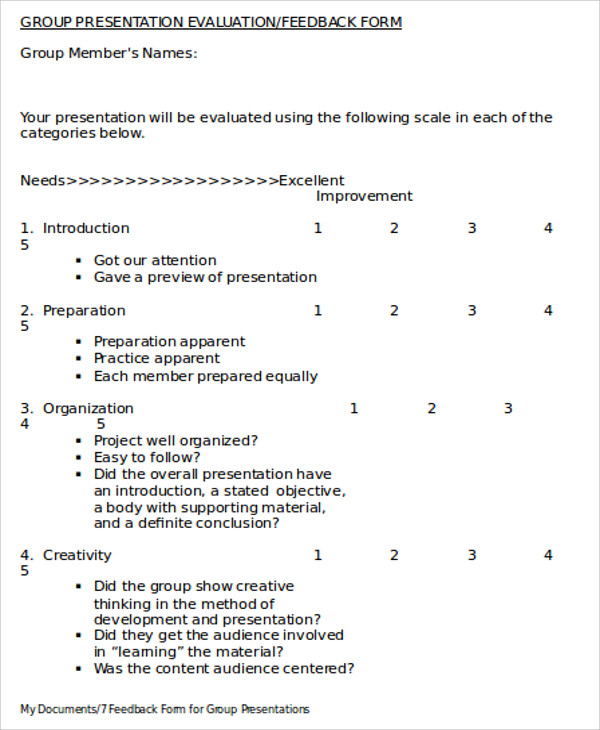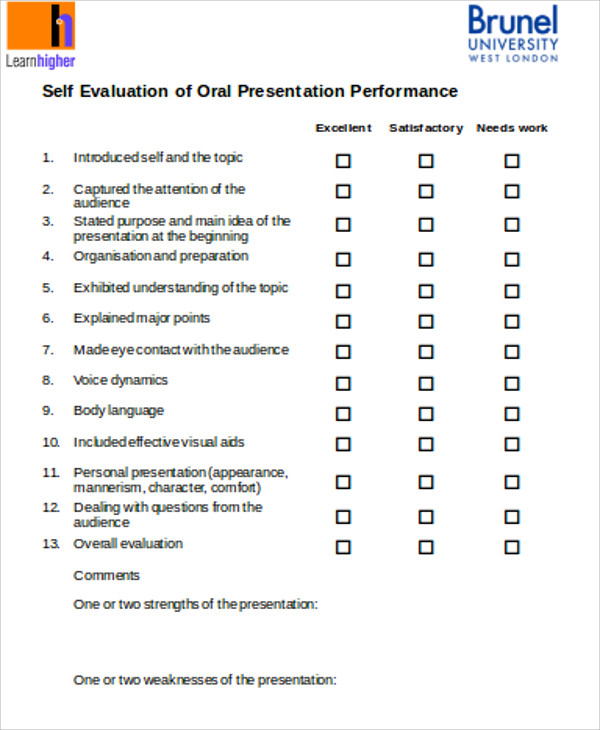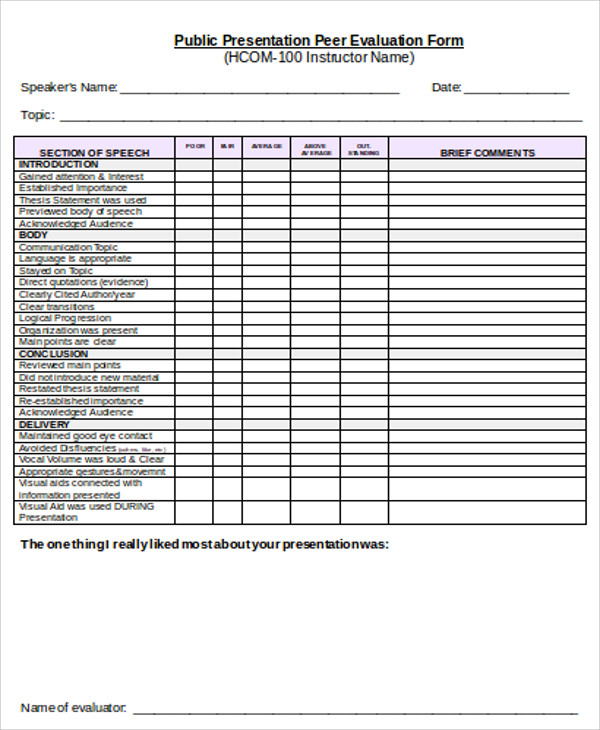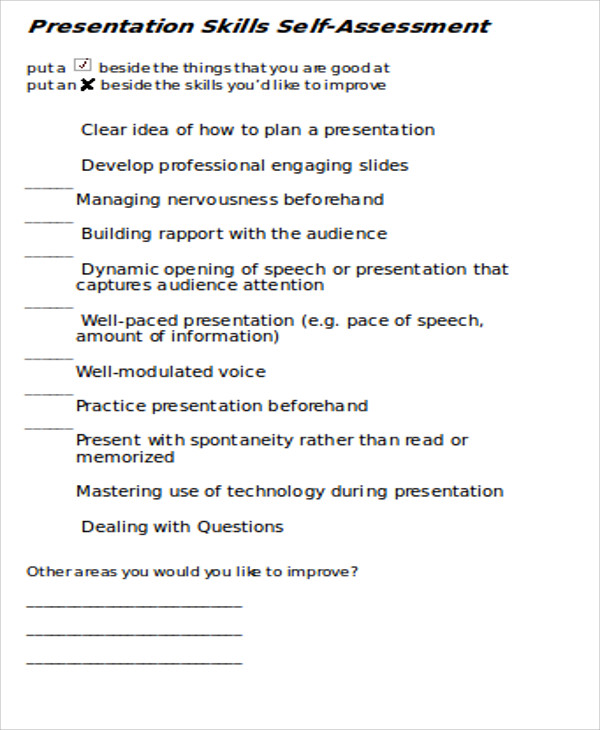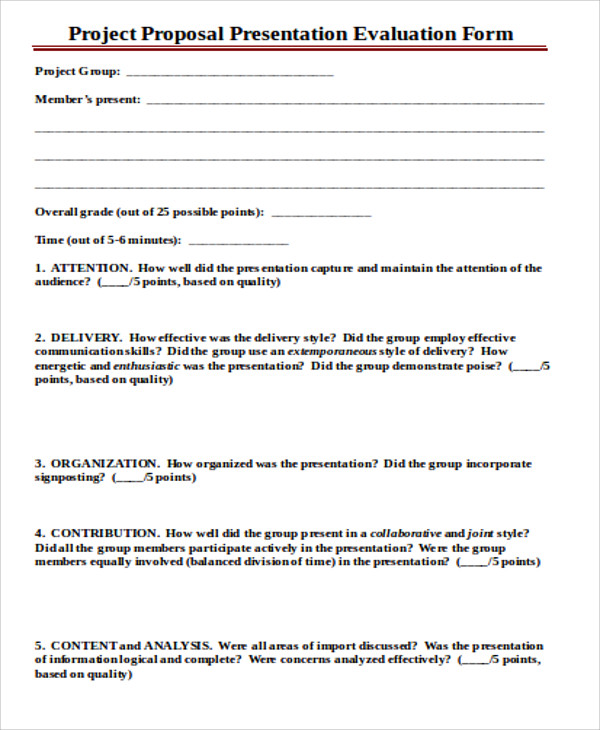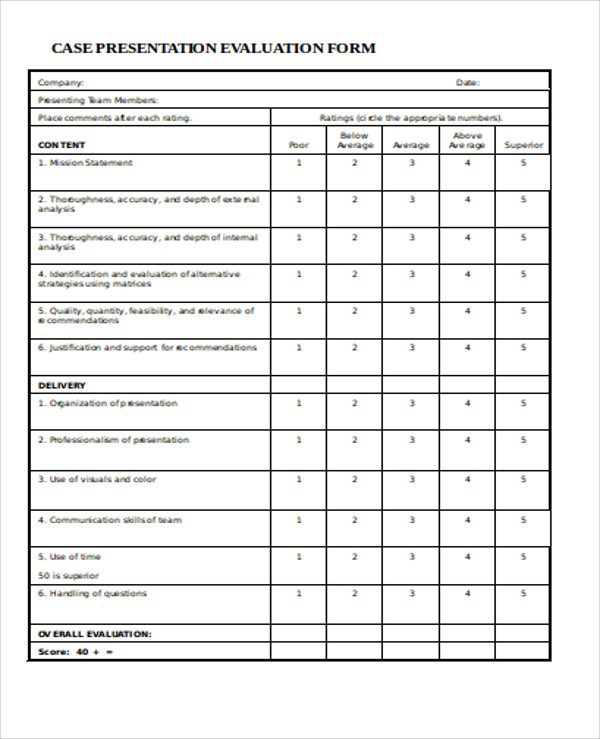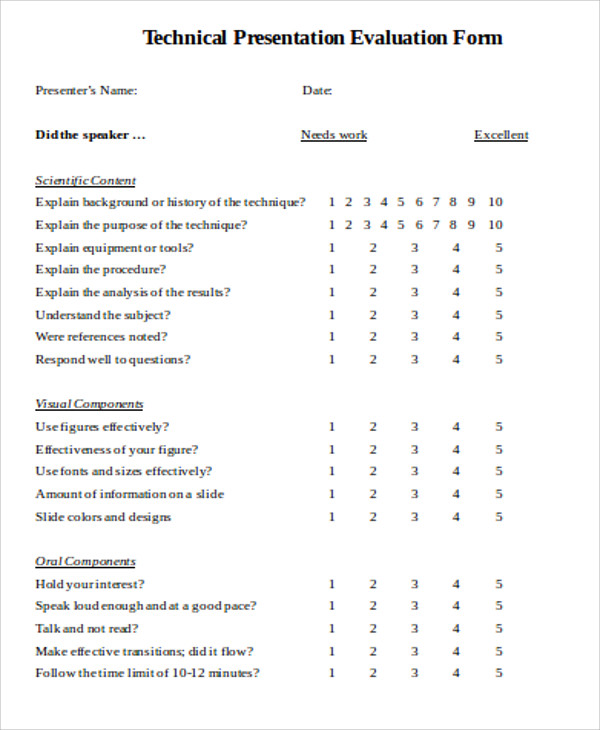Presentations are very important in terms of relaying the information that the people who are viewing the presentation needs to know. A comprehensive presentation does not only need to have a great content. The way that the presentation sample looks and how all the content has been presented are also essential parts of the entire presentation.
Presentations are very important in terms of relaying the information that the people who are viewing the presentation needs to know. A comprehensive presentation does not only need to have a great content. The way that the presentation sample looks and how all the content has been presented are also essential parts of the entire presentation.
Presentations must also be subject to evaluation to know whether they are useful and effective or not. We can provide samples of presentation evaluation forms and other Sample Forms that you may use for the specific purposes that they may serve.
Presentation Evaluation Form
Presentation Feedback Form
What is a presentation evaluation form?
A presentation evaluation form is a document or tool used to assess and provide feedback on the effectiveness of a presentation. It is commonly used in educational, business, or event settings to gather opinions and insights from the audience or participants. The form typically includes various criteria that assess different aspects of the presentation. Common elements found in a presentation evaluation form may include:
- Content and Message Clarity: Assessing the clarity, relevance, and depth of the presentation content.
- Delivery and Communication Skills: Evaluating the presenter’s speaking style, confidence, and ability to engage the audience.
- Visual Aids and Materials: Reviewing the effectiveness of slides, visuals, handouts, or any supporting materials used during the presentation.
- Interaction and Engagement: Assessing the presenter’s interaction with the audience, ability to respond to questions, and overall audience engagement.
- Organization and Structure: Evaluating the logical flow, organization, and structure of the presentation, including the introduction, main points, and conclusion.
- Time Management: Assessing the presenter’s ability to manage time effectively and stay within the allotted presentation time.
- Overall Impact: Providing an overall assessment of the impact and effectiveness of the presentation on the audience.
Presentation evaluation forms are valuable tools for presenters to receive constructive feedback, identify areas for improvement, and gauge the audience’s perception of their performance. They are also useful for organizers and educators to assess the success of an event or training plan. The specific criteria on the form can be customized based on the goals and objectives of the presentation.
Evaluation Form For Presentation
What are the 5 criteria of judging?
- Relevance: Judges assess how closely the subject or performance aligns with the given criteria or the intended purpose. A strong entry is directly related to the requirements or objectives.
- Creativity/Originality: This criterion measures the uniqueness, innovation, and original thought demonstrated in the subject, project, or performance. Creative and original elements often stand out in evaluations.
- Quality/Execution: Judges consider the overall quality of the work, looking at the level of skill, precision, and attention to detail. High-quality execution reflects a mastery of the subject or task.
- Impact/Effectiveness: This criterion evaluates the overall impact or effectiveness of the entry. It assesses how well the subject or performance achieves its intended goals and resonates with the audience.
- Presentation/Presentation Skills: Judges evaluate how well the entry is presented or performed. This includes aspects such as communication, clarity, organization, and the ability to engage and connect with the audience.
These criteria are often used in various contexts, such as competitions, assessments, or reviews, to provide a structured and fair evaluation process. It’s important to note that the specific criteria may vary depending on the nature of the subject or event being judged.
How do you judge a good presentation?
A good presentation is typically judged based on several key factors:
- Clarity of Message: A successful presentation conveys a clear and focused message. The audience should easily understand the main points without confusion.
- Engagement: A good presenter captures the audience’s attention and maintains engagement throughout the presentation. This can be achieved through compelling visuals, storytelling, or interactive elements.
- Effective Visuals: Well-designed slides or visuals enhance understanding and retention. They should be visually appealing, uncluttered, and support the key points of the presentation.
- Confidence and Delivery: A confident and articulate speaker is crucial. Good eye contact, varied tone, and effective pacing contribute to a polished and professional delivery.
- Relevance: The content should be relevant and tailored to the audience. A good presentation addresses the needs and interests of the listeners.
- Structure: A well-organized presentation has a clear structure, including an introduction, main points, and a conclusion. Transitions between sections should be smooth.
- Interaction and Q&A Handling: Encouraging audience interaction and effectively handling questions contribute to a dynamic presentation. A good presenter is responsive to the audience.
- Time Management: Keeping to the allotted time demonstrates respect for the audience’s time and organizational skills. A good presentation avoids rushing or dragging on excessively.
- Adaptability: The ability to adapt to unexpected changes or challenges during the presentation showcases professionalism and preparedness.
- Memorability: A good presentation leaves a lasting impression. Memorable elements, such as impactful stories or visuals, can make the content more memorable for the audience.
Ultimately, the success of a presentation is measured by its ability to effectively communicate the intended message, engage the audience, and leave a positive and lasting impact.
Presentation Evaluation Form Template
Inclusions of a Presentation Evaluation Form
A basic presentation evaluation form includes the following information:
- the name and details of the presented,
- the date when the presentation has been made,
- the topic that a specific presentation has been made,
- the effectiveness of the presentation,
- the features of the presentation,
- the delivery of the purpose of the presentation,
- the organization and the entire flow of the ideas included in the presentation,
- the process of understanding the a specific presentation has provided,
- the tools and equipment used in the presentation, and
- the engagement of the audience in the presentation.
It is also usual for a presentation to have questions regarding the following information:
- the strengths and weaknesses of the presentation,
- the areas of improvement that the presentation may consider,
- the important items that the presentation has delivered, and
- other suggestions and comments of the people who have attended the presentation.
Other than our presentation evaluation samples, we can also provide you with downloadable Presentation Evaluation Forms and Group Self Evaluation Forms.
Presentation Evaluation Sheet
Presentation Skills Evaluation Form Free
Presentation Self-Evaluation Form in Word
Printable Presentation Evaluation Form
Presentation Feedback Form Template Word
Short Presentation Evaluation Form
The Presenter
More than the content of the presentation, the presenter also plays a vital role in the success of a presentation. Here are a few items where the presenter may be evaluated:
- A presenter must be aware of the topic
- A presenter must exude professionalism and confidence with regards to discussing the topics of the presentation
- A presenter must be knowledgeable of everything that he or she is to say
- Expertise in the specific topic is also essential for a presenter to have
- The communication and presentation techniques of the presenter also matters
- A presented must be well organized
- A presented must be prepared with the presentation to assure that he or she is aware of the flow and content of the entire presentation
- The clarity and the effectiveness of the presenter’s delivery
Other Presentation Factors Subjected for Evaluation
More than the presenter, here are other items included in the presentation that are subjected for evaluation:
- The location where the presentation has been made
- The physical conditions in the location of the presentation
- The duration of time intended for the presentation
- The relation of the presentation to the areas of expertise and interest of the attendees
- The purpose on why a presentation has to be made
- The functions of other people who are involved in the presentation
- The technicalities of the presentation
A presentation evaluation is very essential to know the outcome of the presentation and know all the areas that are needed to be evaluated for their functions and effectiveness. Aside from our presentation evaluation templates and samples, you may also browse through our Leadership Evaluation Forms.
General FAQs
1. How do Presentation Evaluation Forms benefit presenters?
Presentation Evaluation Forms offer valuable insights into content, delivery, and audience impact, empowering presenters to enhance their skills through constructive feedback.
2. What criteria are typically included in Presentation Evaluation Forms?
Criteria encompass content clarity, delivery, visual aids, audience engagement, organization, time management, and overall presentation impact.
3. Can Presentation Evaluation Forms be customized for specific events or industries?
Yes, these forms are versatile and can be tailored to suit unique goals, ensuring relevance to diverse presentation contexts, including events and industries.
4. How do Presentation Evaluation Forms contribute to continuous improvement?
By pinpointing areas for enhancement, these forms guide presenters in refining their skills, ultimately supporting ongoing professional development plan and improved audience communication.
5. Are Presentation Evaluation Forms only for presenters, or can organizers benefit from them as well?
Organizers can leverage these forms to assess the success of events, workshops, or training sessions, helping refine future presentations and enhance overall event planning.
6. What role do Presentation Evaluation Forms play in audience satisfaction?
These forms enable audiences to provide feedback on what resonates with them, ensuring future presentations align with audience expectations and contribute to higher satisfaction levels.
7. Can Presentation Evaluation Forms be used in educational settings?
Absolutely. These forms are valuable tools in educational environments, facilitating student assessments report, refining teaching methods, and ensuring effective knowledge transfer through impactful presentations.
In conclusion, presentation evaluation forms are essential tools for assessing the effectiveness of a presentation. They provide valuable feedback sample on content, delivery, and overall impact, aiding presenters in refining their skills. Utilized in various settings, these forms contribute to continuous improvement, ensuring presentations meet audience expectations and communication goals.
Related Posts
FREE 12+ Sample Deed of Gift Forms in PDF
FREE 9+ Sample Photography Consent Forms in MS Word | PDF
FREE 11+ Sample Parts Order Forms in MS Word | PDF
FREE 13+ Requisition Form Samples in PDF | MS Word
FREE 17+ ACH Form Samples in PDF
FREE 9+ Sample Vendor Evaluation Forms in MS Word | PDF
FREE 17+ W2 Form Samples in PDF
FREE 23+ Minor Form Samples in MS Word | PDF
FREE 9+ Sample Students Feedback Forms in PDF | MS Word
FREE 18+ Check Form Samples in MS Word | Google Docs | Pages | PDF
FREE 21+ Notification Form Samples in MS Word | Outlook | PDF
FREE 7+ Sample Audition Forms in PDF | MS Word
FREE 10+ School Clearance Form Samples & Templates in MS Word | PDF
FREE 19+ Study Form Samples in MS Word | PDF
FREE 8+ Sample Pledge Forms in PDF | MS Word
